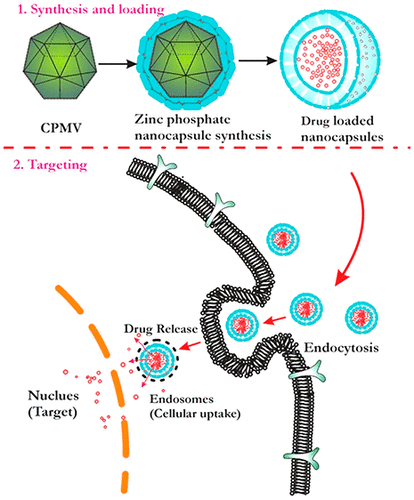当前位置:
X-MOL 学术
›
ACS Appl. Bio Mater.
›
论文详情
Our official English website, www.x-mol.net, welcomes your
feedback! (Note: you will need to create a separate account there.)
Biomimicked and CPMV-Imprinted Hollow Porous Zinc Phosphate Nanocapsules and Their Therapeutic Efficiency
ACS Applied Bio Materials ( IF 4.6 ) Pub Date : 2020-08-24 , DOI: 10.1021/acsabm.0c00634 Koushi Kumar 1, 2 , Pradip Paik 2, 3
ACS Applied Bio Materials ( IF 4.6 ) Pub Date : 2020-08-24 , DOI: 10.1021/acsabm.0c00634 Koushi Kumar 1, 2 , Pradip Paik 2, 3
Affiliation

|
Hollow zinc phosphate nanocapsules (hZPNCs) are an alloplastic biomaterial that has been synthesized to deliver chemotherapeutic drugs in a sustained manner. A very simple one-pot synthesis approach has been employed to synthesize hZPNCs by using cowpea mosaic virus (CPMV) in the presence of phosphate buffer (PBS) (0.01 M PBS, pH ∼7.2) with zinc acetate precursor. The synthesis mechanism of hZPNCs relies on the basis of biomineralization, where the precursor molecules initiate mineralization with the help of amino acid residues present on the CPMV capsid. The synthesized hollow nanocapsules were of diameter ∼50–60 nm and porous shell with thickness of ∼4 nm. The cavity performed as a reservoir for the anticancer drugs (DOX and IM). The release kinetic studies show the positive aspect of hZPNCs to be labeled as drug delivery cargo for sustained delivery. In vitro cytotoxic studies of hZPNCs and hZPNCs-chemo drugs on HEK293, HEPG2, and K562 cells were performed. The cytotoxic studies show that hZPNCs-DOX and hZPNCs-IM arrest the cell cycle of carcinoma cells (HEPG2 and K562 cells) at relatively low IC50 and that the inhibition efficiency is dosage dependent. Furthermore, through HRTEM, in vitro cellular interactions of carcinoma cells with hZPNCs and chemo drug-loaded hZPNCs were confirmed by the cryo-sectioning of cells before and after the incubation. These studies revealed the likely endocytic pathway for the nanocapsules entering the cell and executing the specific action of delivering the anticancer drugs. Together, these results reveal the hZPNCs as potential sustained drug delivery agents.
中文翻译:

仿生和 CPMV 印迹中空多孔磷酸锌纳米胶囊及其治疗效率
空心磷酸锌纳米胶囊 (hZPNCs) 是一种异体生物材料,已被合成以持续输送化疗药物。在磷酸盐缓冲液 (PBS) (0.01 M PBS, pH ∼7.2) 和醋酸锌前体的存在下,使用豇豆花叶病毒 (CPMV) 合成了一种非常简单的一锅法合成 hZPNCs。hZPNCs 的合成机制依赖于生物矿化的基础,其中前体分子在 CPMV 衣壳上的氨基酸残基的帮助下开始矿化。合成的中空纳米胶囊直径为~50-60 nm,多孔外壳厚度为~4 nm。该腔充当抗癌药物(DOX 和 IM)的储存库。释放动力学研究表明,hZPNCs 被标记为药物输送货物以实现持续输送的积极方面。进行了 hZPNCs 和 hZPNCs-化疗药物对 HEK293、HEPG2 和 K562 细胞的体外细胞毒性研究。细胞毒性研究表明,hZPNCs-DOX 和 hZPNCs-IM 在相对较低的 IC 下阻止癌细胞(HEPG2 和 K562 细胞)的细胞周期50并且抑制效率与剂量有关。此外,通过 HRTEM,癌细胞与 hZPNCs 和载有化学药物的 hZPNCs 的体外细胞相互作用通过细胞在孵育前后的冷冻切片得到证实。这些研究揭示了纳米胶囊进入细胞并执行递送抗癌药物的特定作用的可能的内吞途径。总之,这些结果揭示了 hZPNCs 作为潜在的持续药物递送剂。
更新日期:2020-09-21
中文翻译:

仿生和 CPMV 印迹中空多孔磷酸锌纳米胶囊及其治疗效率
空心磷酸锌纳米胶囊 (hZPNCs) 是一种异体生物材料,已被合成以持续输送化疗药物。在磷酸盐缓冲液 (PBS) (0.01 M PBS, pH ∼7.2) 和醋酸锌前体的存在下,使用豇豆花叶病毒 (CPMV) 合成了一种非常简单的一锅法合成 hZPNCs。hZPNCs 的合成机制依赖于生物矿化的基础,其中前体分子在 CPMV 衣壳上的氨基酸残基的帮助下开始矿化。合成的中空纳米胶囊直径为~50-60 nm,多孔外壳厚度为~4 nm。该腔充当抗癌药物(DOX 和 IM)的储存库。释放动力学研究表明,hZPNCs 被标记为药物输送货物以实现持续输送的积极方面。进行了 hZPNCs 和 hZPNCs-化疗药物对 HEK293、HEPG2 和 K562 细胞的体外细胞毒性研究。细胞毒性研究表明,hZPNCs-DOX 和 hZPNCs-IM 在相对较低的 IC 下阻止癌细胞(HEPG2 和 K562 细胞)的细胞周期50并且抑制效率与剂量有关。此外,通过 HRTEM,癌细胞与 hZPNCs 和载有化学药物的 hZPNCs 的体外细胞相互作用通过细胞在孵育前后的冷冻切片得到证实。这些研究揭示了纳米胶囊进入细胞并执行递送抗癌药物的特定作用的可能的内吞途径。总之,这些结果揭示了 hZPNCs 作为潜在的持续药物递送剂。











































 京公网安备 11010802027423号
京公网安备 11010802027423号